The Effects of Shot Distance and Impact Sequence on the Residual Stress Field in Shot Peening Finite Element Model
Abstract
:1. Introduction
2. FE Model Setup
2.1. FE-Geometric-Model Setup
2.2. Material Model Setup
2.3. Coverage Calculation and Residual Stress Evaluation Method
3. Results and Discussion
3.1. The Effect of Shot Distance on the Residual Stress State in Ordered Dimple Pattern SP Model
3.2. The Effect of Impact Sequence on the Residual Stress State in Order Dimple Pattern SP Model
3.3. The Effect of Evaluation Area on the Residual Stress State in SP Model
4. Conclusions
Author Contributions
Funding
Institutional Review Board Statement
Informed Consent Statement
Data Availability Statement
Acknowledgments
Conflicts of Interest
References
- Ganesh, B.; Sha, W.; Ramanaiah, N.; Krishnaiah, A. Effect of shotpeening on sliding wear and tensile behavior of titanium implant alloys. Mater. Des. 2014, 56, 480–486. [Google Scholar] [CrossRef]
- AlMangour, B.; Yang, J.-M. Improving the surface quality and mechanical properties by shot-peening of 17-4 stainless steel fabricated by additive manufacturing. Mater. Des. 2016, 110, 914–924. [Google Scholar] [CrossRef]
- Li, H.; Liu, Y.; Li, M.; Liu, H. The gradient crystalline structure and microhardness in the treated layer of TC17 via high energy shot peening. Appl. Surf. Sci. 2015, 357, 197–203. [Google Scholar] [CrossRef]
- Hassani-Gangaraj, S.; Cho, K.; Voigt, H.-J.; Guagliano, M.; Schuh, C. Experimental assessment and simulation of surface nanocrystallization by severe shot peening. Acta Mater. 2015, 97, 105–115. [Google Scholar] [CrossRef]
- Zhang, S.B.; Bu, Z.Y. Finite element simulation on residual stress field of 2024 aluminum alloy after shot peening with a number of random projectiles. Mater. Mech. Eng. 2016, 40, 87–90. [Google Scholar]
- Nam, Y.-S.; Jeon, U.; Yoon, H.-K.; Shin, B.-C.; Byun, J.-H. Use of response surface methodology for shot peening process optimization of an aircraft structural part. Int. J. Adv. Manuf. Technol. 2016, 87, 2967–2981. [Google Scholar] [CrossRef]
- Scuracchio, B.G.; Lima, N.B.; Schön, C.G. Role of residual stresses induced by double peening on fatigue durability of auto-motive leaf springs. Mater. Des. 2013, 47, 672–676. [Google Scholar] [CrossRef]
- Kirkhope, K.; Bell, R.; Caron, L.; Basu, R.; Ma, K.-T. Weld detail fatigue life improvement techniques. Part 2: Application to ship structures. Mar. Struct. 1999, 12, 477–496. [Google Scholar] [CrossRef]
- Deguchi, T.; Mouri, M.; Hara, J.; Kano, D.; Shimoda, T.; Inamura, F.; Fukuoka, T.; Koshio, K. Fatigue strength improvement for ship structures by Ultrasonic Peening. J. Mar. Sci. Technol. 2012, 17, 360–369. [Google Scholar] [CrossRef]
- Hardy, C.; Baronet, C.N.; Tordion, G.V. The elasto-plastic indentation of a half-space by a rigid sphere. Int. J. Numer. Methods Eng. 1971, 3, 451–462. [Google Scholar] [CrossRef]
- Bhuvaraghan, B.; Srinivasan, S.M.; Maffeo, B. Numerical simulation of Almen strip response due to random impacts with strain-rate effects. Int. J. Mech. Sci. 2011, 53, 417–424. [Google Scholar] [CrossRef]
- Sanjurjo, P.; Rodríguez, C.; Peñuelas, I.; García, T.E.; Belzunce, F.J. Influence of the target material constitutive model on the numerical simulation of a shot peening process. Surf. Coat. Technol. 2014, 258, 822–831. [Google Scholar] [CrossRef]
- Klemenz, M.; Schulze, V.; Vöhringer, O.; Löhe, D. Finite Element Simulation of the Residual Stress States after Shot Peening. Mater. Sci. Forum 2006, 524, 349–354. [Google Scholar] [CrossRef]
- Miao, H.; Larose, S.; Perron, C.; Lévesque, M. On the potential applications of a 3D random finite element model for the simulation of shot peening. Adv. Eng. Softw. 2009, 40, 1023–1038. [Google Scholar] [CrossRef]
- Jebahi, M.; Gakwaya, A.; Lévesque, J.; Mechri, O.; Ba, K. Robust methodology to simulate real shot peening process using dis-crete-continuum coupling method. Int. J. Mech. Sci. 2016, 107, 21–33. [Google Scholar] [CrossRef] [Green Version]
- Liu, Z.; Xiu, L.; Wu, J.; Lv, G.; Ma, J. Numerical simulation on residual stress eliminated by shot peening using SPH method. Fusion Eng. Des. 2019, 147, 111231. [Google Scholar] [CrossRef]
- Shivpuri, R.; Cheng, X.; Mao, Y. Elasto-plastic pseudo-dynamic numerical model for the design of shot peening process parameters. Mater. Des. 2009, 30, 3112–3120. [Google Scholar] [CrossRef]
- Bagherifard, S.; Ghelichi, R.; Guagliano, M. A numerical model of severe shot peening (SSP) to predict the generation of a nanostructured surface layer of material. Surf. Coat. Technol. 2010, 204, 4081–4090. [Google Scholar] [CrossRef]
- Huang, H.; Wang, Z.; Gan, J.; Yang, Y.; Wang, X.; He, J.; Gan, X. The study of universality of a method for predicting surface nanocrystallization after high energy shot peening based on finite element analysis. Surf. Coat. Technol. 2019, 358, 617–627. [Google Scholar] [CrossRef]
- Wu, G.; Wang, Z.; Gan, J.; Yang, Y.; Meng, Q.; Wei, S.; Huang, H. FE analysis of shot-peening-induced residual stresses of AISI 304 stainless steel by considering mesh density and friction coefficient. Surf. Eng. 2019, 35, 242–254. [Google Scholar] [CrossRef]
- Meguid, S.; Shagal, G.; Stranart, J. Finite element modelling of shot-peening residual stresses. J. Mater. Process. Technol. 1999, 92-93, 401–404. [Google Scholar] [CrossRef]
- Hong, T.; Ooi, J.; Shaw, B. A numerical simulation to relate the shot peening parameters to the induced residual stresses. Eng. Fail. Anal. 2008, 15, 1097–1110. [Google Scholar] [CrossRef]
- Mylonas, G.; Labeas, G. Numerical modelling of shot peening process and corresponding products: Residual stress, surface roughness and cold work prediction. Surf. Coat. Technol. 2011, 205, 4480–4494. [Google Scholar] [CrossRef]
- Baragetti, S. Shot peening optimisation by means of ‘DOE’: Numerical simulation and choice of treatment parameters. Int. J. Mater. Prod. Tech. 1997, 12, 83–109. [Google Scholar]
- Xie, L.; Wang, C.; Wang, L.; Wang, Z.; Jiang, C.; Lu, W.; Ji, V. Numerical analysis and experimental validation on residual stress distribution of titanium matrix composite after shot peening treatment. Mech. Mater. 2016, 99, 2–8. [Google Scholar] [CrossRef] [Green Version]
- Yang, C.; Hodgson, P.D.; Liu, Q.; Ye, L. Geometrical effects on residual stresses in 7050-T7451 aluminum alloy rods subject to laser shock peening. J. Mater. Process. Technol. 2008, 201, 303–309. [Google Scholar] [CrossRef]
- Meguid, S.; Shagal, G.; Stranart, J. 3D FE analysis of peening of strain-rate sensitive materials using multiple impingement model. Int. J. Impact Eng. 2002, 27, 119–134. [Google Scholar] [CrossRef]
- Schwarzer, J.; Schulze, V.; Vöhringer, O. Evaluation of the Influence of Shot Peening Parameters on Residual Stress Profiles Using Finite Element Simulation. Mater. Sci. Forum 2003, 426-432, 3951–3956. [Google Scholar] [CrossRef]
- Society of Automotive Engineers. Shot Peening Coverage. Surface Vehicle Recommended Practice; SAE Standard J2277:2013; Society of Automotive Engineers: Warrendale, PA, USA, 2013. [Google Scholar]
- Klemenz, M.; Schulze, V.; Rohr, I.; Löhe, D. Application of the FEM for the prediction of the surface layer characteristics after shot peening. J. Mater. Process. Technol. 2009, 209, 4093–4102. [Google Scholar] [CrossRef]
- Kim, T.; Lee, J.H.; Lee, H.; Cheong, S.-K. An area-average approach to peening residual stress under multi-impacts using a three-dimensional symmetry-cell finite element model with plastic shots. Mater. Des. 2010, 31, 50–59. [Google Scholar] [CrossRef]
- ElTobgy, M.S.; A Elbestawi, M.; Ng, E. Three-dimensional elastoplastic finite element model for residual stresses in the shot peening process. Proc. Inst. Mech. Eng. Part. B J. Eng. Manuf. 2004, 218, 1471–1481. [Google Scholar] [CrossRef]
- Sheng, X.F. Research on Shot Peening Strengthening Mechanism of Civil Aircraft Structural Parts with Corrosion Damage. Ph.D. Thesis, South China University of Technology, Guang Zhou, China, 2014. [Google Scholar]
- Wang, C. Study of Shot Peening Simulation and Fatigue Crack Growth Behavior. Ph.D. Thesis, Zhejiang University of Technology, Hang Zhou, China, 2016. [Google Scholar]
- Kim, T.; Lee, H.; Hyun, H.C.; Jung, S. Effects of Rayleigh damping, friction and rate-dependency on 3D residual stress simulation of angled shot peening. Mater. Des. 2013, 46, 26–37. [Google Scholar] [CrossRef]
- Chen, J.S.; A Desai, D.; Heyns, S.P.; Pietra, F. Literature review of numerical simulation and optimisation of the shot peening process. Adv. Mech. Eng. 2019, 11, 1–19. [Google Scholar] [CrossRef]
- Salahi, A.A.A.; Othman, R. Constitutive equations of yield stress sensitivity to strain rate of metals: A comparative study. J. Eng. 2016, 2016. [Google Scholar] [CrossRef] [Green Version]
- Huang, H.M. Research on FEM in High Energy Shot Peening Surface Nanocrystallization and Parameters Optimization of 42CrMo Steel for Automobile Shafts. Master’s Thesis, Wuhan University of Technology, Wuhan, China, 2019. [Google Scholar]
- Wang, X.; Wang, Z.; Wu, G.; Gan, J.; Yang, Y.; Huang, H.; He, J.; Zhong, H. Combining the finite element method and response surface methodology for optimization of shot peening parameters. Int. J. Fatigue 2019, 129, 105231. [Google Scholar] [CrossRef]
- He, J.; Wang, Z.; Gan, J.; Yang, Y.; Wang, X.; Shi, M.; Ren, X. Numerical simulation research on surface integrity of 42CrMo steel after double shot peening. Surf. Technol. 2020, 49, 216–223. [Google Scholar] [CrossRef]
- Kirk, D.; Abyaneh, M.Y. Theoretical basis of shot peening coverage control. In Proceedings of the 5th International Conference on Shot Peening, Linköping, Sweden, 16–18 June 1993; pp. 183–190. [Google Scholar]
- Moore, M.G.; Evans, W.P. Mathematical correction for stress in removed layers in X-ray diffraction RS analysis. SAE Trans. 1958, 66, 340–345. [Google Scholar]
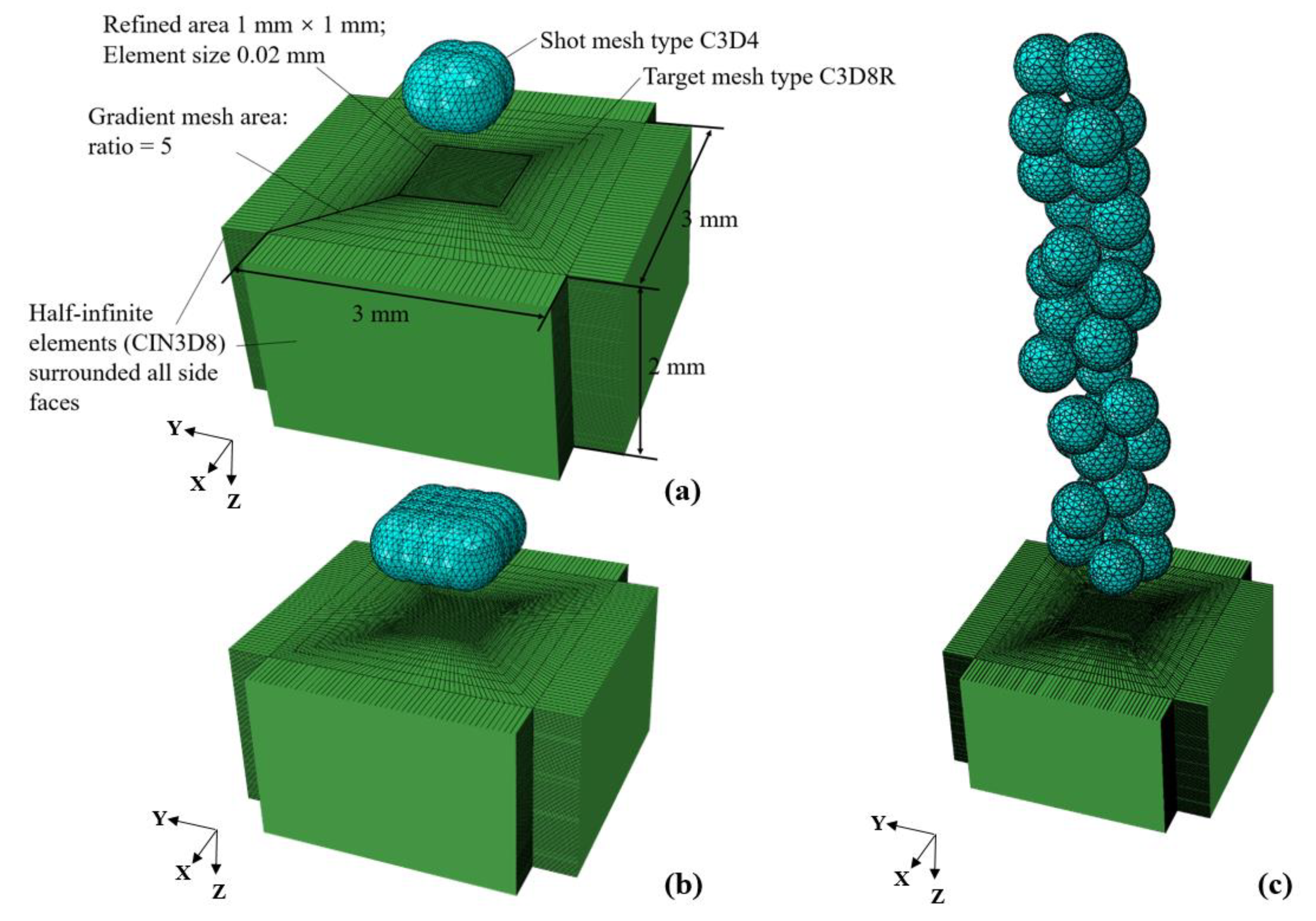



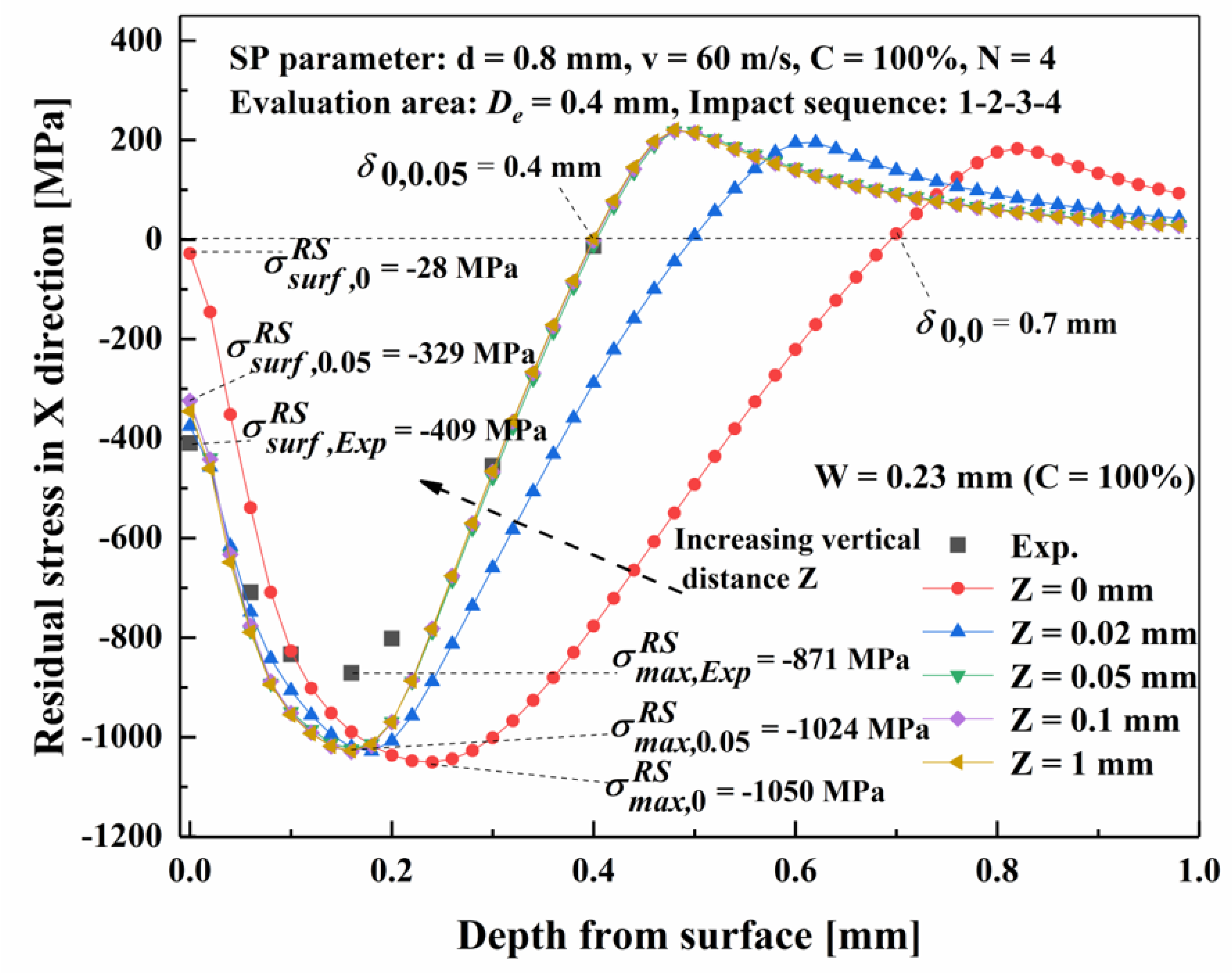

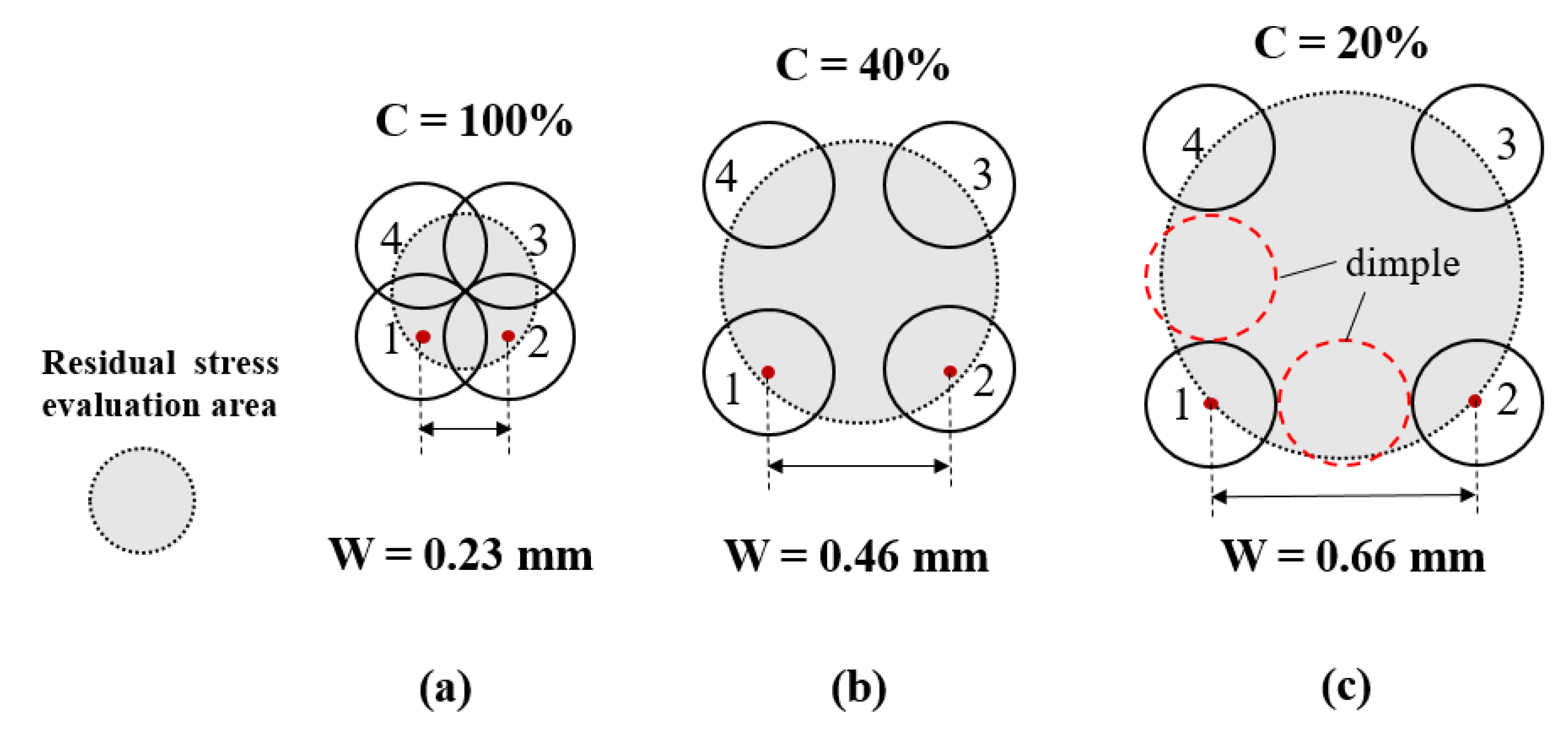
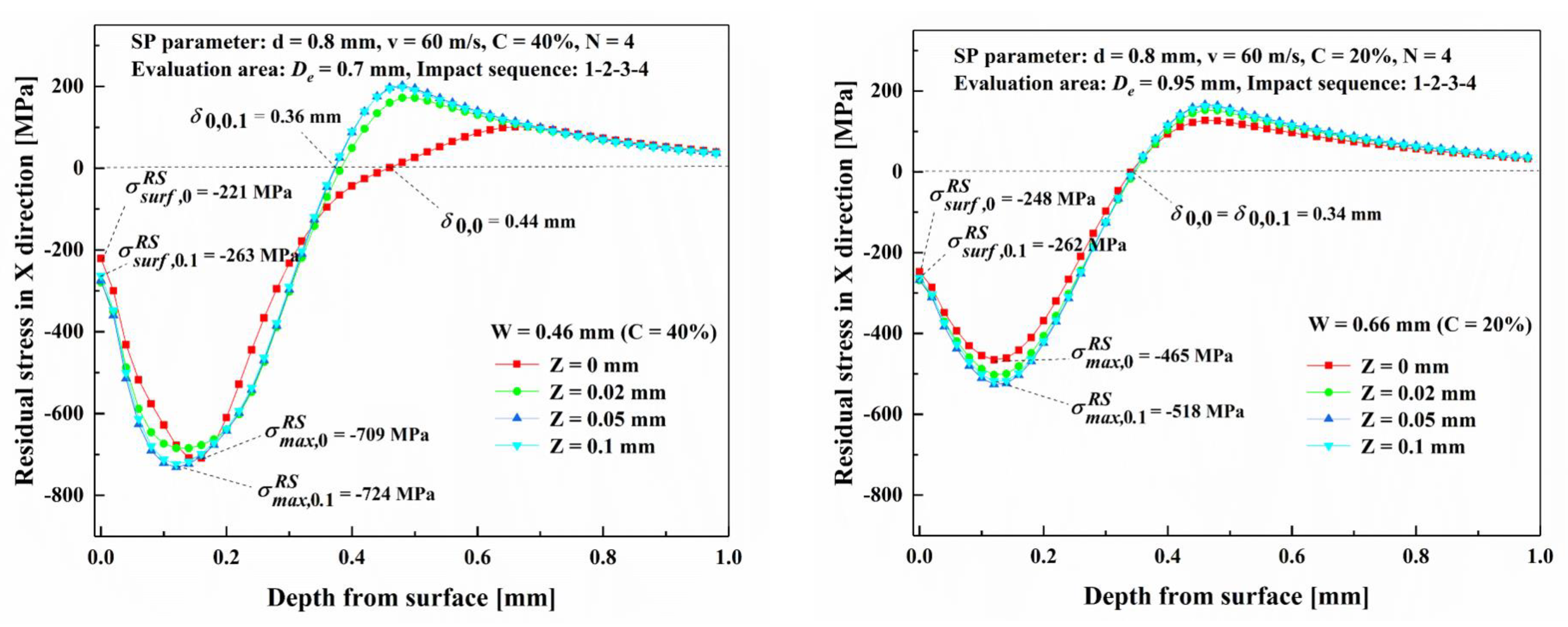

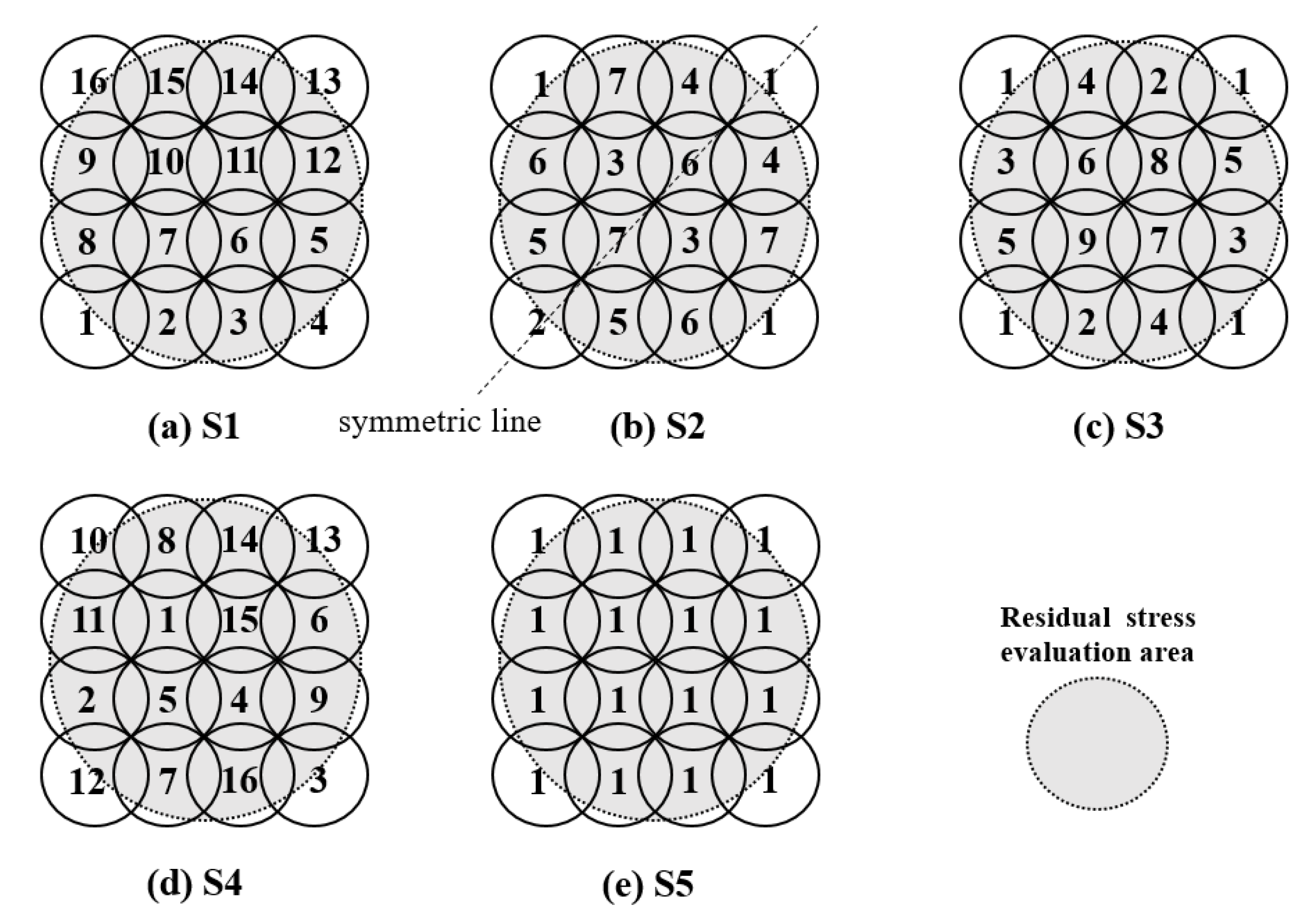
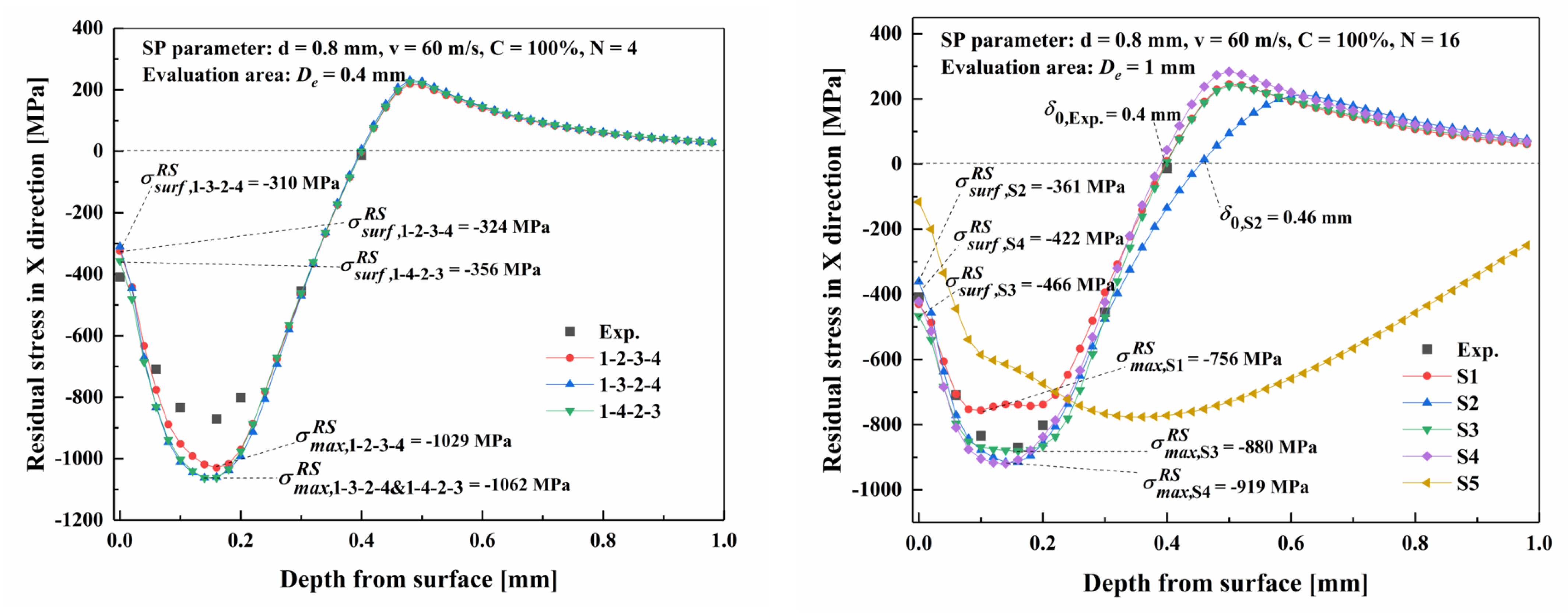
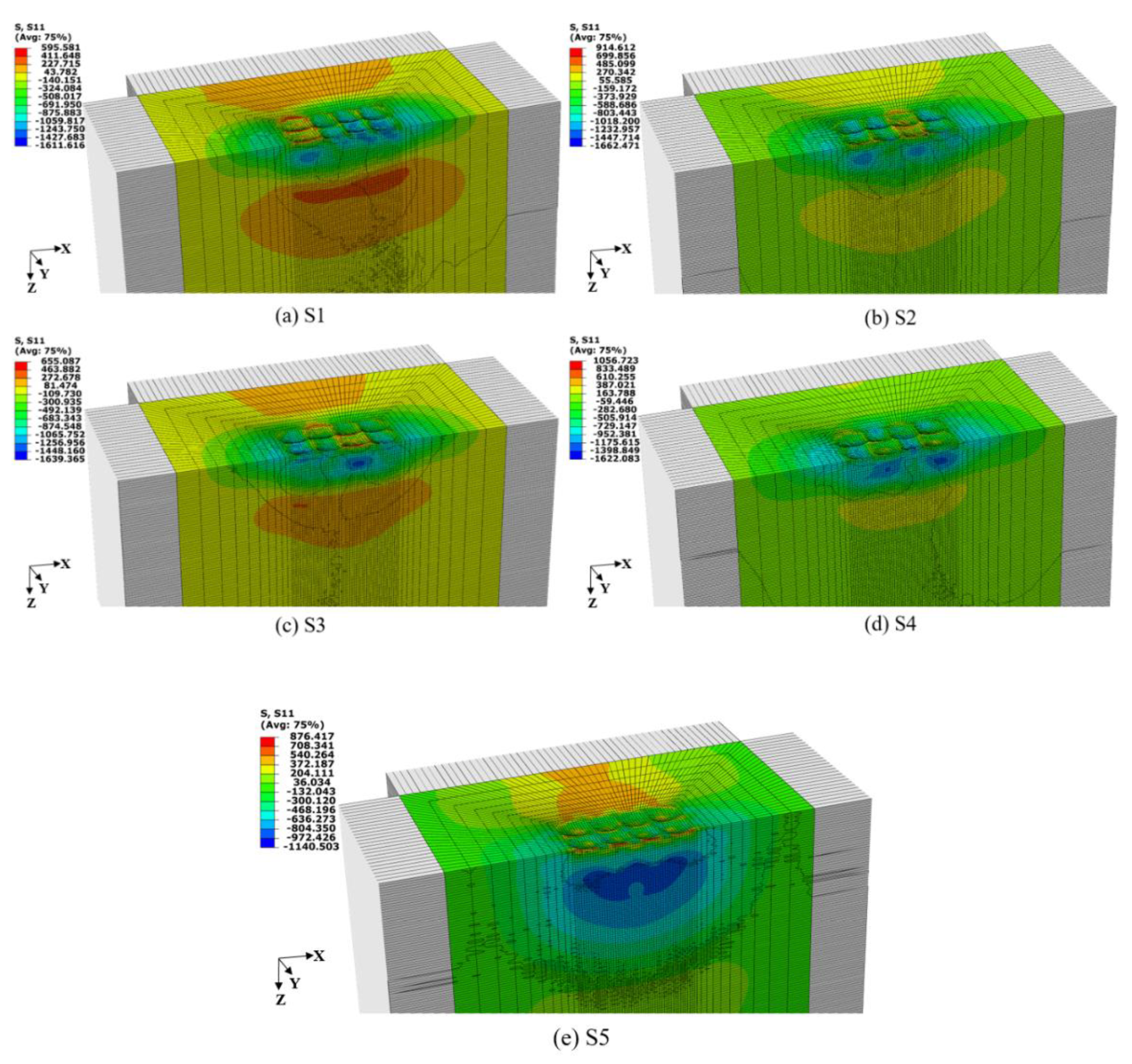
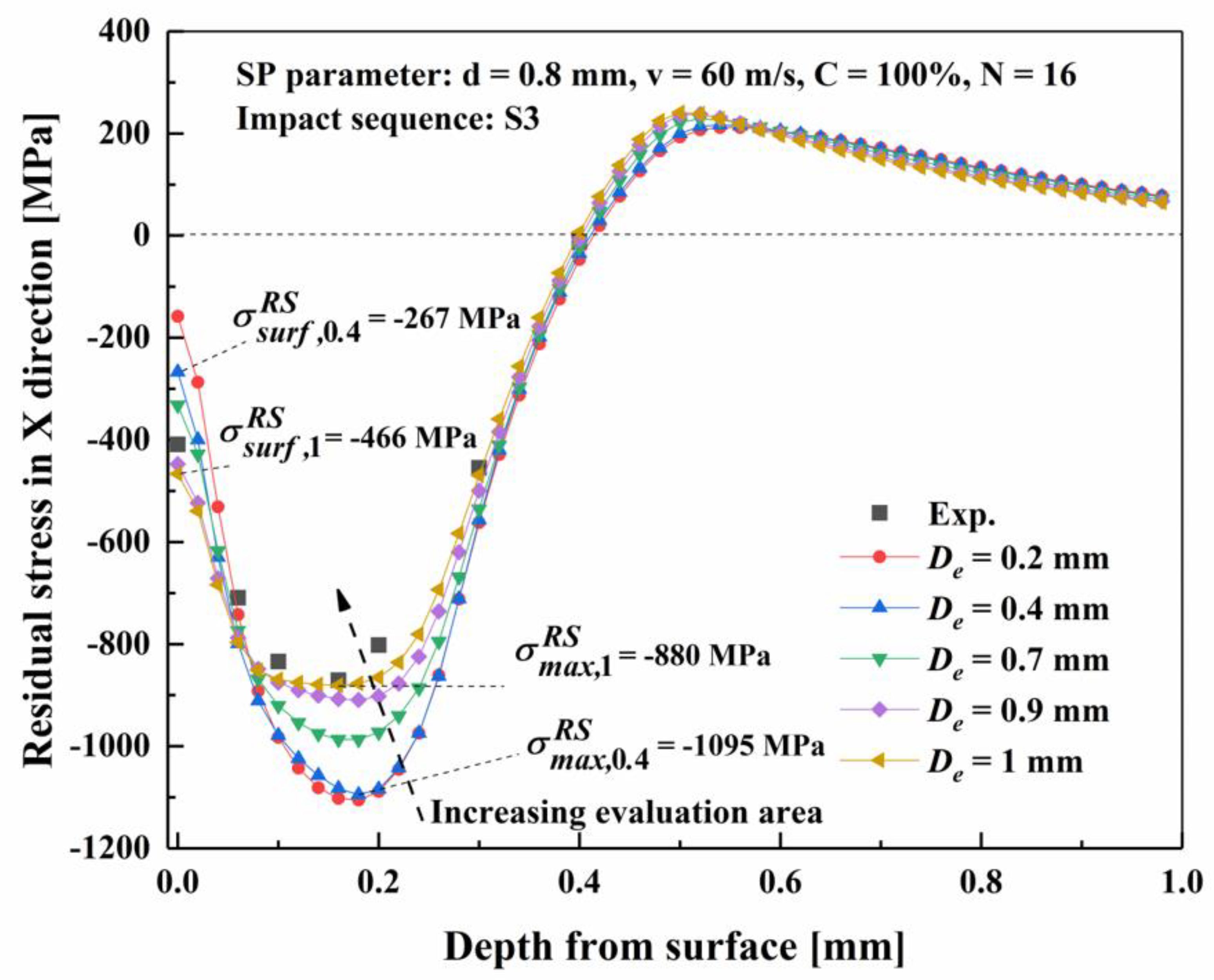


| Material | E/GPa | v | ρ/kg m−3 | A/MPa | B/MPa | n | m | C |
|---|---|---|---|---|---|---|---|---|
| 42CrMo | 208 | 0.3 | 7830 | 680 | 510 | 0.26 | 1.03 | 0.015 |
Publisher’s Note: MDPI stays neutral with regard to jurisdictional claims in published maps and institutional affiliations. |
© 2021 by the authors. Licensee MDPI, Basel, Switzerland. This article is an open access article distributed under the terms and conditions of the Creative Commons Attribution (CC BY) license (http://creativecommons.org/licenses/by/4.0/).
Share and Cite
Wang, Z.; Shi, M.; Gan, J.; Wang, X.; Yang, Y.; Ren, X. The Effects of Shot Distance and Impact Sequence on the Residual Stress Field in Shot Peening Finite Element Model. Metals 2021, 11, 462. https://doi.org/10.3390/met11030462
Wang Z, Shi M, Gan J, Wang X, Yang Y, Ren X. The Effects of Shot Distance and Impact Sequence on the Residual Stress Field in Shot Peening Finite Element Model. Metals. 2021; 11(3):462. https://doi.org/10.3390/met11030462
Chicago/Turabian StyleWang, Zhou, Ming Shi, Jin Gan, Xiaoli Wang, Ying Yang, and Xudong Ren. 2021. "The Effects of Shot Distance and Impact Sequence on the Residual Stress Field in Shot Peening Finite Element Model" Metals 11, no. 3: 462. https://doi.org/10.3390/met11030462






